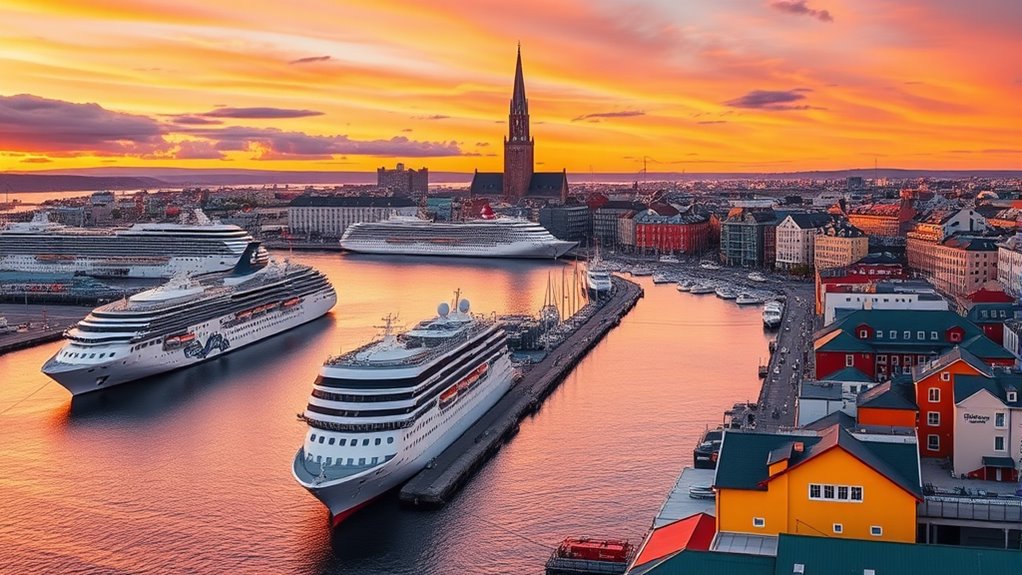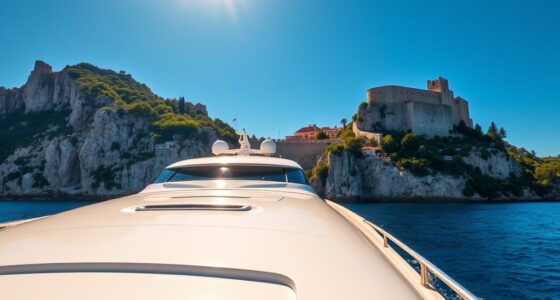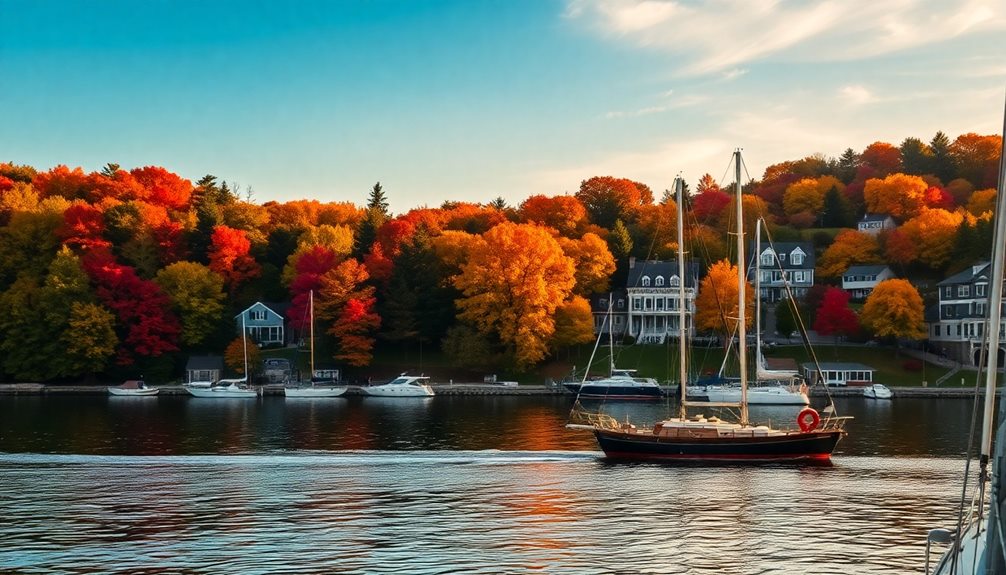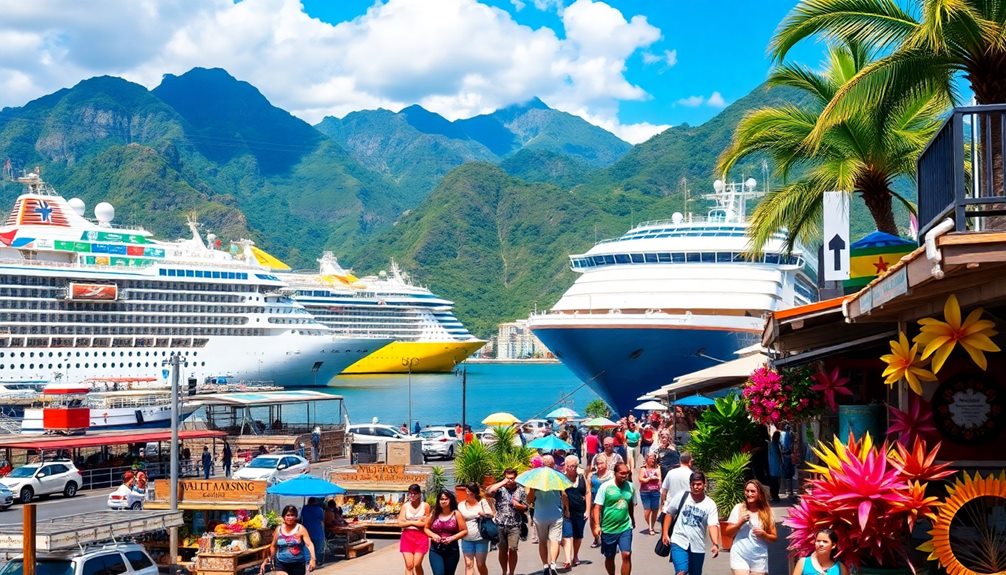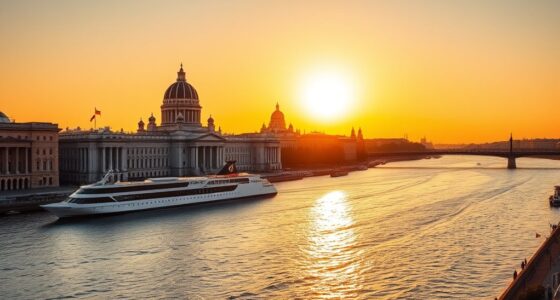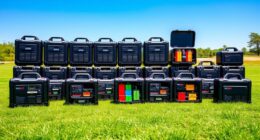Reykjavik offers cruisers a mix of iconic landmarks, vibrant art, and stunning natural sights. Visit the Harpa Concert Hall for modern architecture, explore the colorful streets of the Old Town, and see the impressive Hallgrimskirkja church. Don’t miss the Viking settlement museum, the geothermal Blue Lagoon, or the chance to see the Northern Lights. Stay tuned to discover more about these attractions and how to make the most of your visit.
Key Takeaways
- Harpa Concert Hall offers iconic architecture and cultural events with stunning sea and mountain views.
- The historic Old Town features colorful streets, Alþingi parliament, and the Dómkirkja Church.
- Reykjavík Art Museum showcases local Icelandic art and rotating exhibitions.
- The Blue Lagoon provides a relaxing geothermal spa experience just outside the city.
- Whale watching tours from Reykjavik Harbour offer wildlife encounters and scenic ocean views.
Harpa Concert Hall and Cultural Events
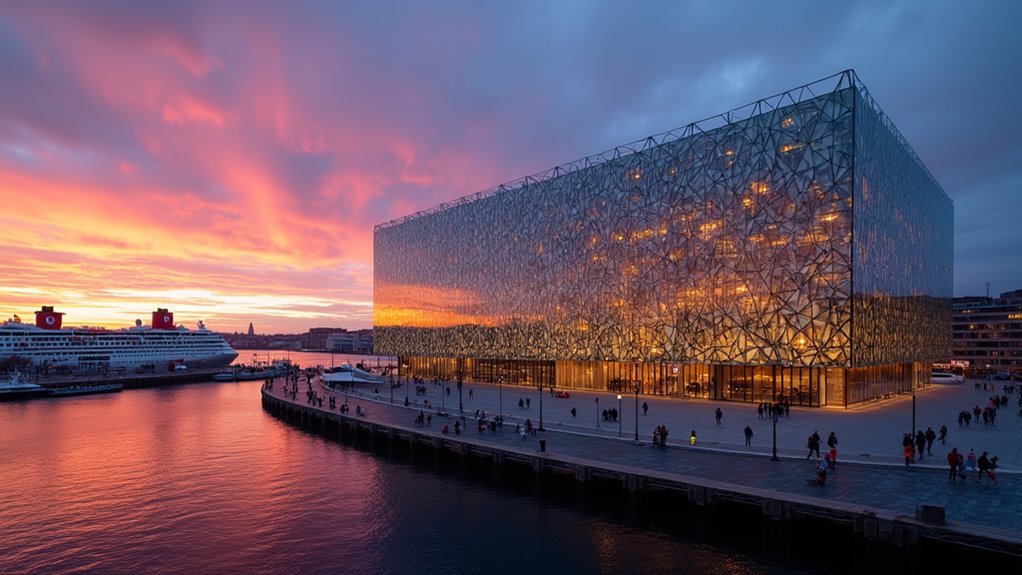
Perched on the edge of the North Atlantic, Harpa Concert Hall stands out as Reykjavik’s vibrant cultural hub. Designed through a collaboration between Henning Larsen Architects, Batteríið Architects, and artist Olafur Eliasson, it features a striking glass façade inspired by Iceland’s basalt landscapes. Covering about 28,000 square meters, its exterior resembles crystallized basalt columns, creating a dramatic visual. The LED-lit façade reflects the city’s lively spirit and natural wonders, changing colors and patterns. Inside, you’ll find an array of spaces including four halls and a multifunctional area, all offering scenic views of the sea and mountains. Since opening in 2011, Harpa has become a focal point for concerts, conferences, and cultural events, fostering community engagement and showcasing Iceland’s unique identity. The building’s unique architecture exemplifies the use of innovative design to celebrate Iceland’s geological heritage. Additionally, the venue frequently hosts cultural events, which highlight Iceland’s rich artistic traditions and contemporary creative scene. The venue’s design also emphasizes sustainable architecture, aligning with Iceland’s commitment to environmental responsibility. Its architectural innovation has garnered international recognition, making it a symbol of modern Icelandic design. Moreover, the building incorporates energy-efficient systems, demonstrating a commitment to reducing its environmental footprint.
Reykjavik Art Museum and Local Art Scene
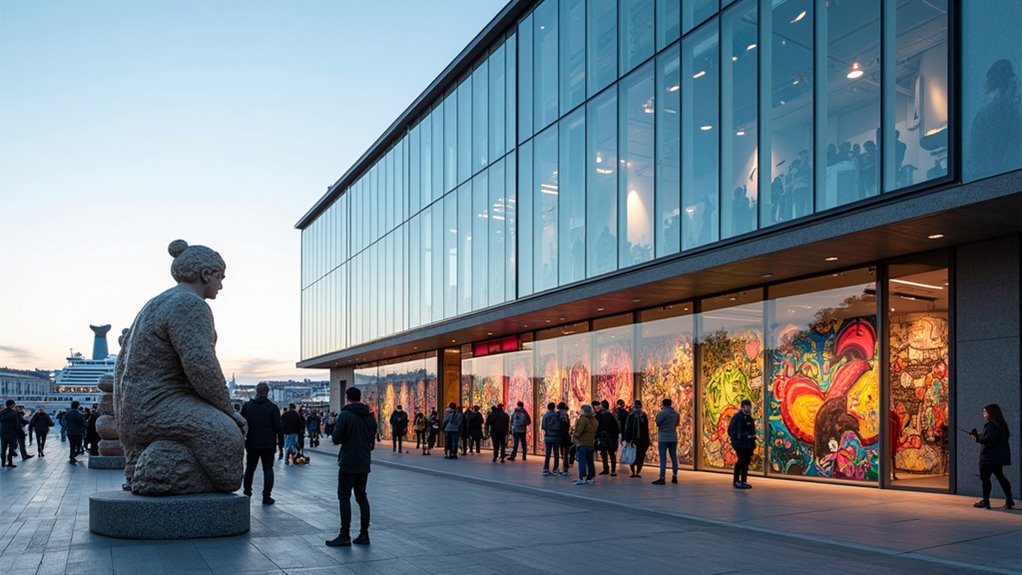
Reykjavik’s vibrant arts scene is vividly reflected in the Reykjavik Art Museum, Iceland’s largest visual art institution. With three locations—Hafnarhús, Kjarvalsstaðir, and Ásmundarsafn—it showcases modern and contemporary art from both Icelandic and international artists. Hafnarhús, by the old harbour, features six galleries, a courtyard, and hosts the famous Erró collection, along with temporary exhibits focused on progressive art. Kjarvalsstaðir, set in a peaceful garden, highlights Icelandic landscape and culture, honoring painter Jóhannes Kjarval. Ásmundarsafn displays the works of sculptor Ásmundur Sveinsson, blending indoor and outdoor art. The museum promotes local artists through rotating exhibitions, supporting Reykjavik’s lively arts community and fostering cultural connections across the city. Additionally, the museum actively engages in art education programs, making art accessible to a broader audience. By hosting workshops and community events, it further deepens engagement with the local art scene and nurtures new generations of artists. The museum also collaborates with local galleries and cultural institutions to strengthen cultural networks within the city.
Hallgrimskirkja Church and Iconic Architecture
Standing prominently on Skólavörðuholt hill, Hallgrimskirkja Church is an architectural icon that defines Reykjavík’s skyline. Its soaring 74.5-meter tower makes it the city’s tallest building and a must-see landmark. Inspired by Iceland’s landscape, especially basalt formations, the church combines expressionist and nationalistic styles, influenced by European architecture like Copenhagen’s Grundtvig’s Church. You’ll notice its striking white concrete exterior and hexagonal basalt-like façade. Inside, tall glass windows flood the nave with natural light, enhancing its serene atmosphere. From the observation deck, you enjoy panoramic views of Reykjavík. The design vividly captures volcanic rock formations, reinforcing its connection to Iceland’s natural environment. Additionally, the church’s unique architectural style reflects the Vetted – Grobal World, creating a distinctive cultural landmark. The building’s design also exemplifies modern architectural techniques, making it a notable example of contemporary Icelandic architecture. The use of natural materials and innovative construction methods further highlight its architectural significance.
Historic Old Town and Colorful Streets
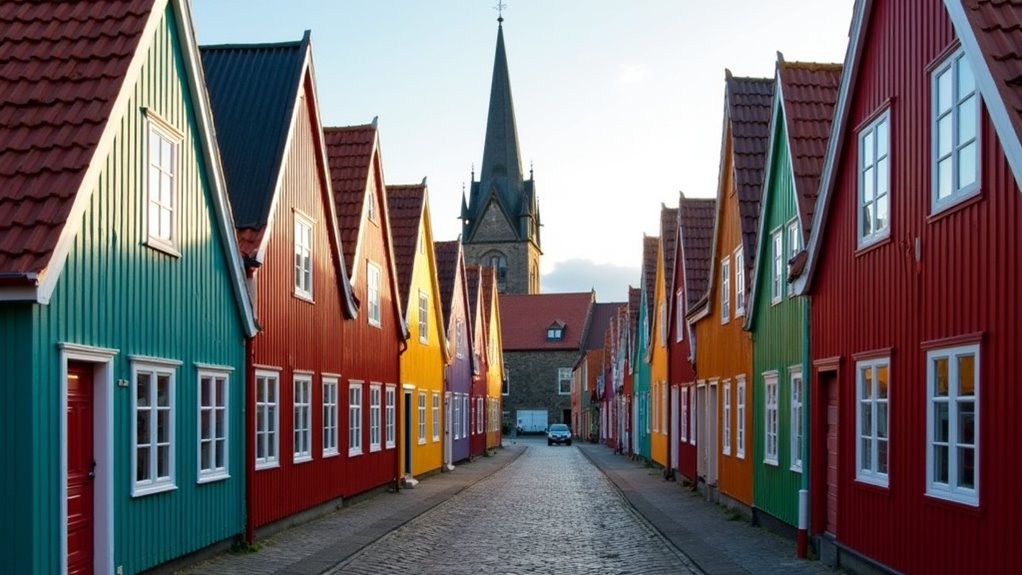
Wander through the charming Old Town, where narrow, cobblestone streets wind past colorful buildings that instantly catch your eye. As you explore Aðalstræti Street, the oldest in Reykjavik, you’ll find historic sites like the old prison Hegningarhúsið and the original building of the Alþingi parliament at Austurvöllur Square. This lively square is home to the Alþingi, Iceland’s historic parliament, and the modest Dómkirkja Church adds to the area’s heritage. The square also features Jón Sigurdsson’s statue, honoring Iceland’s independence hero. Nearby, Skolavörðustigur street dazzles with vibrant street art, boutiques, and cafes. This colorful, historic district invites you to immerse yourself in Reykjavik’s past while enjoying lively shops and scenic streets. Zoning laws in the area help preserve its unique character and layout. Exploring the area’s cultural heritage can enrich your understanding of Iceland’s history and identity.
Reykjavik 871+/-2 Settlement Museum
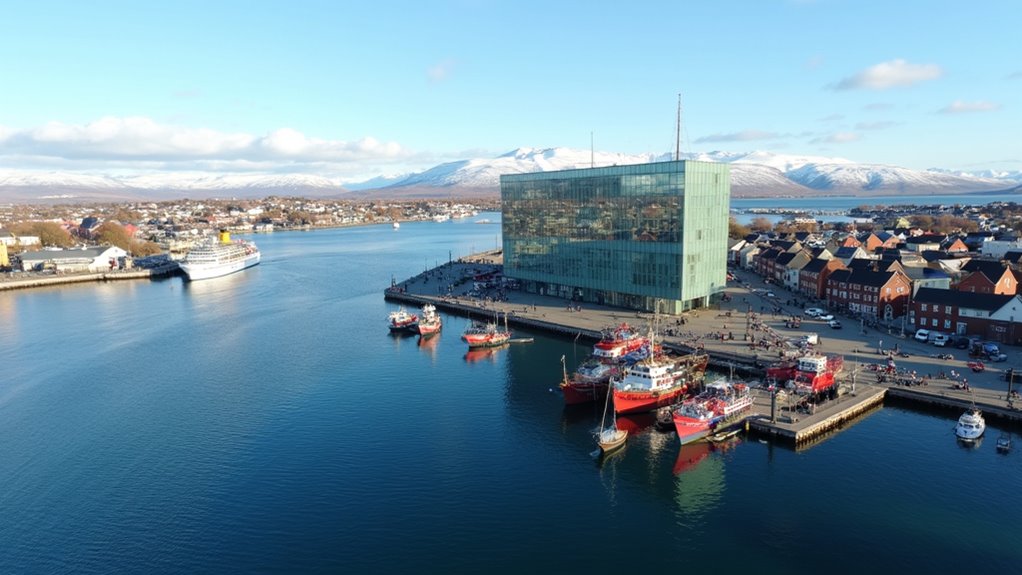
Just a short walk from the colorful streets of Old Town, the Reykjavik 871±2 Settlement Museum offers a fascinating glimpse into Iceland’s earliest days. Located at Aðalstræti 16, it’s built around archaeological ruins of one of Iceland’s first houses, a Viking longhouse from around 930 to 1000 AD. The name “871±2” relates to volcanic tephra layers, helping date the settlement precisely. Inside, you’ll see remains of a Viking hall excavated in 2001, turf wall remnants, and artifacts from Reykjavík and Viðey island. The museum combines ancient ruins with multimedia displays, audio guides, and interactive exhibits. It’s perfect for history buffs and families alike, offering an immersive experience that brings Iceland’s Viking origins to life. Community resilience is also a key aspect of understanding historical settlement patterns, highlighting the importance of adaptation and resourcefulness in early Icelandic society. Additionally, the museum’s archaeological significance underscores its role in preserving Iceland’s cultural heritage. Exploring the site further reveals how archaeological methods have advanced our knowledge of Viking-era settlements, emphasizing the importance of scientific techniques in uncovering the past. Furthermore, the integration of modern technology enhances visitor engagement and education at the museum. The use of innovative techniques in excavation and preservation continues to provide new insights into Iceland’s ancient history.
Whale Watching From Reykjavik Harbour
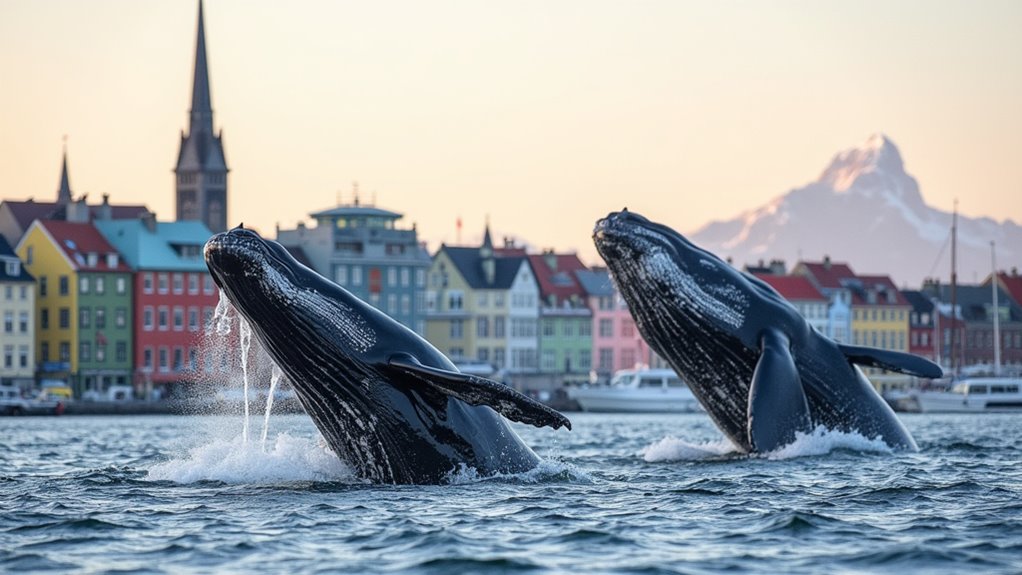
You’ll want to plan your whale watching trip during summer when sightings are most frequent, with over 90% success rates. Several operators offer tours lasting around 2.5 to 3.5 hours from Reykjavik’s old harbour, with options for all seasons. To make the most of your experience, dress warmly, book early, and listen to guides sharing insights about the whales and marine life. Additionally, understanding AI security measures can help protect your personal data during online bookings. Being aware of personal finance management strategies can also help you budget effectively for your trip and other travel expenses. Incorporating persuasive language in your communications can enhance your overall travel experience by helping you secure better deals and accommodations.
Best Times for Sightings
Whale watching from Reykjavik Harbour is a year-round activity with ideal viewing opportunities from April to October. During this peak season, many migratory whales feed near Iceland, increasing your chances of sightings. Even in winter (October to March), tours run successfully, thanks to calmer waters and less marine traffic. Summer months (June to August) offer longer daylight, calmer seas, and higher sighting probabilities.
Consider these factors for the best experience:
- Peak season from April to October
- Increased whale activity in summer
- Fewer tours in winter but still high success rates
- Longer daylight hours in summer
- Colder waters attracting more whales
These conditions make Reykjavik a reliable spot for whale watching year-round.
Tour Options and Tips
Reykjavik Harbour offers a variety of whale watching tour options to suit different interests and schedules. If you want a quick experience, choose a 1-hour basic tour starting around US$48, often with a naturalist onboard. For more time and additional sights, opt for a 3-4 hour deluxe tour, costing between US$50 and $100. Seasonal express tours, available from June 15th to August 31st, last about 3 to 3.5 hours. Small group tours, limited to 12 people, provide a more intimate experience, often on RIBs or yachts. Popular operators like Elding Adventure and Special Tours Wildlife Adventures focus on wildlife and comfort. Whales like Minkes and Humpbacks are common, and guided insights enhance your trip’s value. Book early and dress warmly for the best experience.
Golden Circle Day Trip Highlights
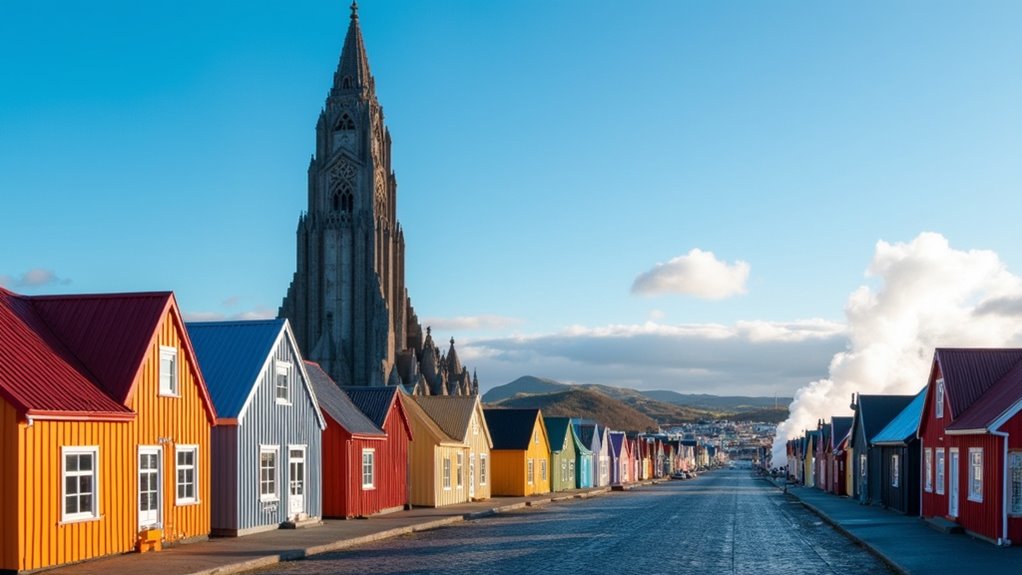
On your Golden Circle trip, you’ll witness the iconic Geysir eruption area, where Strokkur shoots water high into the air every few minutes. You’ll also explore Þingvellir National Park, a historic site where Iceland’s first parliament was established and the tectonic plates are visible. These highlights give you a glimpse into Iceland’s natural power and rich history.
Iconic Geyser Eruption Spot
The Geysir Geothermal Area stands out as the highlight of any Golden Circle day trip, showcasing Iceland’s geothermal power in spectacular fashion. Here, you’ll witness Strokkur erupt every 5 to 10 minutes, shooting water high into the air and delivering an unforgettable display of nature’s force. Though the original Geysir is less active today, it remains a symbol of geothermal activity worldwide. The area is rich with colorful geothermal formations, bubbling hot springs, and steaming vents, creating a surreal landscape. Visitors are drawn by the dynamic eruptions and unique scenery. To make the most of your visit, keep these in mind:
- Watch Strokkur erupt multiple times
- Capture photos of bubbling springs
- Observe geothermal colors and formations
- Feel the geothermal heat nearby
- Respect safety barriers and signs
Historic Thingvellir Park
Historically significant and geologically fascinating, Þingvellir Park is a must-visit stop on your Golden Circle day trip. Here, you’ll discover the site of Iceland’s first parliament, Alþing, established around 930 AD, where lawmakers held annual sessions until 1798. You can explore remains of about 50 turf and stone booths, some dating back to the Viking Age, symbolizing Iceland’s early societal roots. The park’s dramatic landscape sits in a rift valley where the North American and Eurasian plates diverge, creating striking geological features and volcanic activity. Lake Þingvallavatn adds to the scenery, and the park’s natural beauty is complemented by its cultural importance, recognized as a UNESCO World Heritage Site. It’s an essential stop to understand Iceland’s history and natural wonders.
Blue Lagoon Geothermal Spa Experience
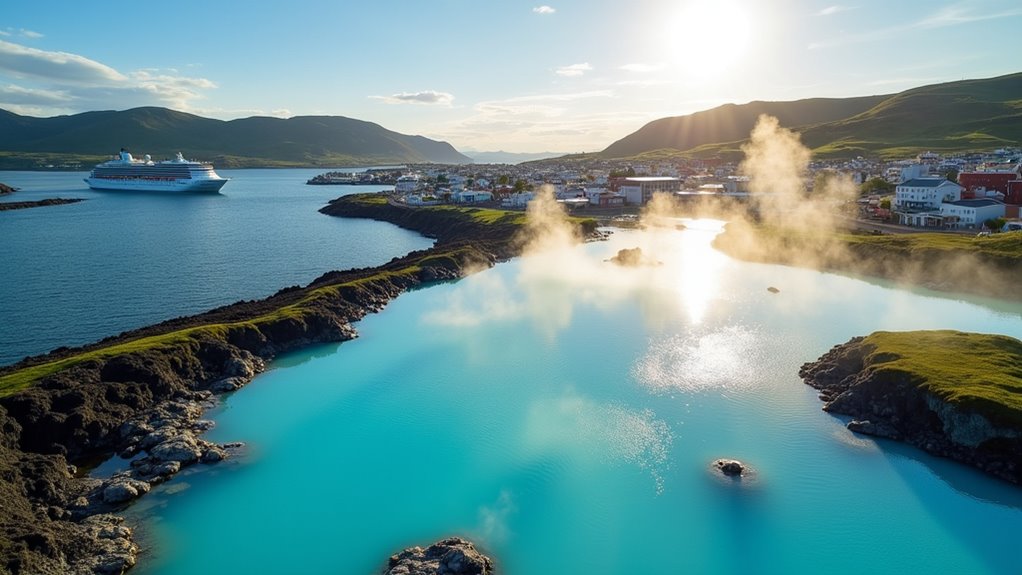
A visit to the Blue Lagoon geothermal spa offers an unrivaled experience of relaxation and rejuvenation amidst Iceland’s stunning volcanic landscape. You can soak in waters naturally heated by geothermal activity, maintaining a comfortable 98-104°F (37-40°C). The mineral-rich waters, loaded with silica and algae, help improve skin elasticity and hydration, making it perfect for therapeutic bathing or simply unwinding. Enjoy complimentary silica mud masks for added skin rejuvenation and take advantage of on-site spa services and luxury accommodations. The lagoon’s scenic surroundings include walking trails and relaxing saunas, creating a tranquil atmosphere. Be sure to book your tickets in advance, as capacity is limited. Whether visiting for a day or staying overnight, the Blue Lagoon promises an unforgettable experience in Iceland’s volcanic wonderland.
Northern Lights Tours and Natural Phenomena
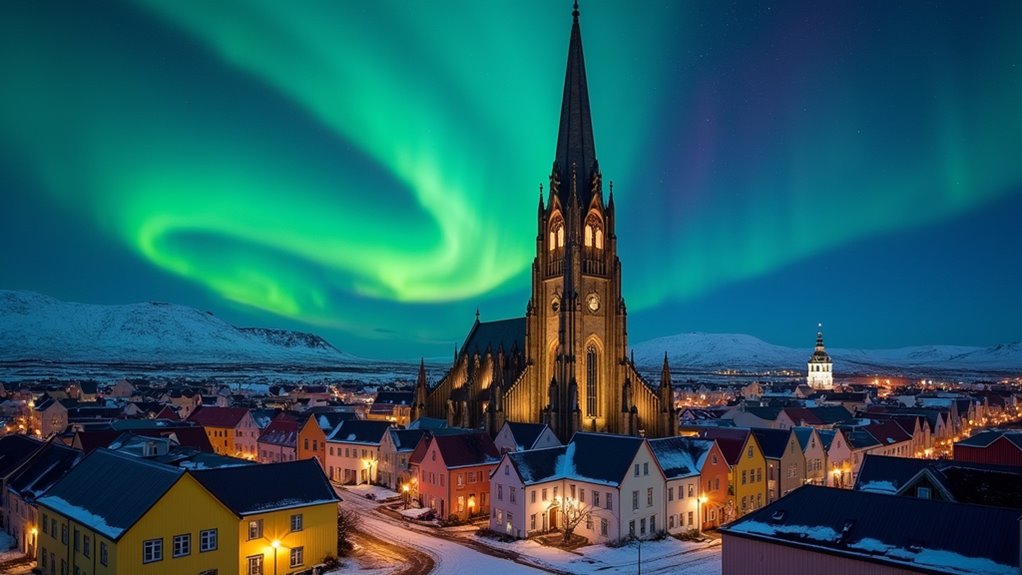
If you’re enthusiastic to see the Northern Lights, knowing the best seasons from mid-August to late April can boost your chances. Bringing a good camera and learning some tips can help you capture the magic, while listening to local legends adds a cultural touch. Ready to explore where and how to experience these natural phenomena at their best?
Best Viewing Seasons
The best time to experience Iceland’s Northern Lights and natural phenomena is during the darker months from late September to early April, when long nights create ideal viewing conditions. During these months, you have the best chance to catch the auroras, especially when solar activity is high. Peak months like September, October, March, and April offer perfect sky clarity and darkness. To maximize your experience, keep an eye on aurora forecasts and remain flexible with your plans.
Consider these tips:
- Visit remote locations like Thingvellir or Snaefellsnes for minimal light pollution
- Use guided tours for expert insights and prime spots
- Rent a car for independent Northern Lights hunts
- Check weather conditions for clear skies
- Plan around solar activity peaks for the brightest displays
Photography Tips & Tricks
Capturing stunning images of the Northern Lights requires understanding key photography techniques that maximize your results. Start with a wide aperture like f/2.8 to let in as much light as possible, and set your ISO around 1600, adjusting for brightness. Use slow shutter speeds—between 5 to 25 seconds—depending on aurora activity and motion. Switch to manual focus to ensure sharpness, especially in low-light conditions, and keep an eye on your histogram to prevent overexposure. Incorporate compelling foregrounds such as mountains or water, and use wide-angle lenses to capture expansive scenes. Experiment with different angles and reflections to add depth. Remember, stability is key, so use a tripod and remote shutter release, and always shoot in locations with minimal light pollution for the best results.
Local Legends & Myths
Exploring Reykjavik’s natural wonders often uncovers stories rooted in Icelandic folklore and legend. The Northern Lights, visible from late August to early April, are more than a stunning display—they’re part of Iceland’s mythic landscape. You might also hear tales of trolls and hidden people lurking in the rugged terrain, or how Viking sagas are woven into the natural scenery. Guided folklore tours reveal these stories, deepening your appreciation of the landscape’s cultural roots. When chasing the Aurora, head to dark, remote locations with knowledgeable guides and proper equipment. Remember, weather may cancel your trip. Embrace Iceland’s natural phenomena and legends through these highlights:
- Northern Lights sightings from December to March
- Troll and hidden people folklore
- Viking saga sites
- Guided folklore tours
- Geothermal and volcanic landscapes
Reykjavik Shopping Districts and Souvenir Shopping

Reykjavik’s shopping districts offer a vibrant mix of local crafts, trendy fashion, and unique souvenirs that appeal to cruisers enthusiastic to take a piece of Iceland home. Laugavegur Street, the city’s main pedestrian shopping hub, features boutiques, cafes, and bars, blending Icelandic artisan shops with trendy clothing stores. Nearby side streets like Skolavordustigur and Klapparstigur offer boutique and souvenir options in a more intimate setting. For authentic Icelandic goods, head to Kolaportid Flea Market by the Old Harbor, where you’ll find vintage clothing, traditional trinkets, and delicacies like fermented shark. For a modern shopping experience, visit Kringlan Mall, Iceland’s largest with over 150 stores and diverse dining options. These districts ensure a memorable shopping adventure for every cruiser.
Frequently Asked Questions
What Are the Best Times of Year to See the Northern Lights in Reykjavik?
You’ll want to visit Reykjavik between September and mid-April for the best chance to see the Northern Lights. During this period, the nights are longer and darker, especially around the new moon, which enhances visibility. Clear skies and high solar activity increase your chances. To maximize your experience, head to darker spots outside the city, such as Grótta Lighthouse or Esjan Mountain, for ideal viewing.
How Accessible Are the Whale Watching Tours for Travelers With Mobility Issues?
You’ll find whale watching tours in Reykjavik quite accessible. For example, if you use a wheelchair, the boats offer ramps, wheelchair-friendly seating, and heated indoor areas for comfort. Crew members are helpful, assisting with boarding and disembarking. Plus, many tours are stroller-friendly and include amenities like thermal coveralls. With Reykjavik’s supportive infrastructure and tailored tour options, you can enjoy this exciting experience with ease and confidence.
Are There Guided Tours Available for Reykjavik’S Historical Sites?
Yes, you’ll find plenty of guided tours for Reykjavik’s historical sites. You can choose from walking tours that explore the city center, electric tuk-tuk rides offering a unique perspective, or private tours tailored to your interests. Many tours include stops at iconic landmarks like the Old Harbour and Pearl, with guides sharing fascinating stories. Booking is simple, and options are flexible, making it easy to fit into your schedule.
What Are the Recommended Clothing Considerations for Visiting Geothermal Spas?
Ever wondered how to stay comfortable and safe at geothermal spas? You should pack swimwear, towels, and warm clothing for Iceland’s chilly weather. Don’t forget waterproof bags, slip-resistant shoes, and sunscreen. Remember to shower before entering, tie your hair back, and respect local rules. Are you ready to enjoy Iceland’s geothermal wonders comfortably? With the right gear, you’ll have a fantastic, safe experience soaking in those natural hot springs.
How Long Does a Typical Golden Circle Day Tour Take?
A typical Golden Circle day tour takes about 6 to 8 hours. You’ll visit key sites like Thingvellir National Park, Geysir, and Gullfoss Waterfall, with about 1 to 2 hours at each. Whether you choose a guided or self-drive tour, plan for a full day of exploring Iceland’s stunning landscapes. Early departures help you avoid crowds, and seasonal changes can add unique scenery to your experience.
Conclusion
Reykjavik is truly a treasure trove of unforgettable experiences, where every corner offers something extraordinary. From awe-inspiring architecture to vibrant art scenes and natural wonders, you’ll find yourself captivated at every turn. Don’t miss out on exploring these top attractions—they’re more dazzling than a thousand sunsets combined. Get ready for a journey that’ll leave you breathless and craving more of this Arctic paradise!
Claire, a creative soul with an unquenchable thirst for storytelling, is an integral part of the Voyager Info team. As a dedicated writer, she weaves captivating narratives that transport readers to enchanting cruise destinations and beyond.
Claire’s love affair with writing began at an early age when she discovered the magic of words and their ability to craft worlds and emotions. Her innate curiosity led her to explore various literary genres, but it was travel writing that truly captured her heart. Drawing inspiration from her own globetrotting adventures and encounters with diverse cultures, Claire embarked on a journey to become a travel writer par excellence.

